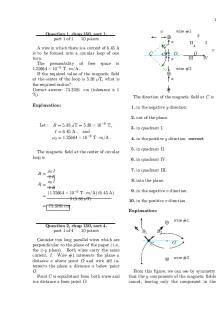Homework Chapter 5 PDF

| Title | Homework Chapter 5 |
|---|---|
| Author | Olivia Cray |
| Course | Introduction to World Religions |
| Institution | State College of Florida, Manatee-Sarasota |
| Pages | 4 |
| File Size | 93.5 KB |
| File Type | |
| Total Downloads | 108 |
| Total Views | 150 |
Summary
Section questions on the chapter...
Description
Shared Origins Offer some general comparisons and contrasts between Jainism and Sikhism. Jainism and Sikhism, like Hinduism, have their roots in India and both their ranks have grown, even outside of their country of origin. They share ties to Hinduism, like a belief in karma and rebirth, though they developed in opposition of Hinduism’s polytheism and ritualism, preferring religious simplicity. Both stress the importance of a person’s individual struggle to act morally and do good, thus working to purify themselves. However, Jainism does not believe in a Creator god. The universe is just natural forces in motion. Sikhism, in contrast, embraces devout monotheism. In Jainism, they are strict about nonattachment and non-harm while Sikhism allows military self defense and even meat eating. Jainism—Background Describe some features Jainism shares with Buddhism. Both Buddhism and Jainism grew out of opposition of Vedic religion, finding influence in Hinduism. They share beliefs in reincarnation, rebirth of the soul in a new body and in ahimsa. Mahavira and the Origins of Jainism 1. What is some of the symbolism behind the image of the twenty-four tirthankaras? The term tirthankaras can be translated as crossing makers or ford finder. The idea was not for them to inspire the image of a bridge but rather the crossing of a river. The point of the name was that one could not cross said river without getting wet and going through the river itself. Thusly, one could not fully purify themselves without going through life and putting forth the effort for such liberation themselves. 2. Discuss the traditional life story of Mahavira. Mahavira shared many similarities with the Buddha. He was born into an aristocratic family. Unlike Buddha, he was the second son and held less responsibilities than his older brother. He was free to leave home at 30 and wander as a holy man. As he wandered, he embraced extreme asceticism. To prevent himself from forming attachments he moved constantly, meeting harshness where he went. People would harass him, and dogs would attack him and in the face of this, he renounced the world. 12 years of this harsh, unattached life and he experienced great liberation and felt fully in control of himself. For the rest of his life, he taught his doctrines and organized an order of monks who were as naked as he had found himself at the end of his spiritual journey. Worldview 1. What are the philosophic arguments Jainism uses to defend its atheism? 1. If God is perfect, why did God create a universe that is imperfect? 2. If God made the universe because of love, why is the world so full of suffering beings? 3. If the universe had to be created, did not God also need to be created? 4. And where did God come from in the beginning? 2. How does Jainism conceive time? Jainism conceives time as a series of regular cycles of rise and fall. For this religion there is no beginning at all, and the universe is eternal. 3. Explain the dualism found in Jainism and how it shapes understanding of human beings. In Jainism, all parts of the universe are made up of two differing types of reality known as Jiva and Ajiva. Considered spirit and matter, the two are said to often intermix. Jiva is what is alive while Ajiva is not alive and not conscious. Humans are
made up of both. Our Ajiva side seeks pleasure, escape from pain and engages in matters of self-interest. Meanwhile the Jiva side of humans sees escape from the bondage of the material world. 4. How are human beings different from other things composed of matter and spirit? Unlike other things composed of matter and spirit, humans are aware of their dualistic aspects. This awareness gives them the ability to overcome their limitations through discipline. 5. Discuss the Jain goal and the understanding of karma and rebirth. The ultimate goal of Jainism is to reach a state of total freedom, hoping to move up the scale of rebirth or even escape the chains of rebirth to achieve this liberation, all of which is controlled by karma. 6. What role do superhuman beings occupy in Jainism? Superhuman beings in Jainism exist in higher realms thought to be the top of the universe as well as in painful realms below that of the earth. Those higher beings are believed to offer assistance to people on earth who pray to them. Jain Ethics 1. Explain ahimsa and how this ethical recommendation is lived out. Ahimsa, or nonviolence, serves as the foundation for Jain ethics. For monks and nuns, they follow the belief that Mahavira swept the ground as he walked and even before he sat down to avoid crushing any insects and so they did the same. For those considered laypeople, they avoided jobs wherein animals and insects would be harmed, like that of hunting, fishing and farming. 2. Briefly describe the ethical recommendations of nonlying, nonstealing, and chastity. Lies and exaggerations were considered dangerous to the Jains because of the potential to cause hurt, thus violating ahimsa. At the same time, absolute truth was considered impossible because every person will see situations from a unique point of view. When it came to nonstealing, it was believed that stealing came from improper desires. Stealing also caused pain to those being stolen from, which again violated ahimsa. As for chastity, in the case of nuns and monks, strict celibacy was expected. For those who were married, they were expected to be faithful. Sex was seen as a danger to liberation, serving as a bind to the physical world and created passions could potentially harm others. 3. Discuss the importance of nonattachment for Jains. Attachments were seen to contribute to the bondage keeping spirits to this realm, with some, like money, taking complete control of an individual. The ultimate goal in Jainism was freedom from the bonds holding them in place. 4. Explain how a "holy death" fits into the Jain religion. The most esteemed method of Sallekhana was considered to be self-starvation, seen as the ultimate, noble expression of nonattachment and freedom. All of life is seen as liberation preparation for the spirit to leave the body. When a person has evolved spiritually enough, garnering enough karma, it is considered acceptable to no longer create more karma. The Development of Jainism and Its Branches 1. Discuss similarities and differences between Buddha and Mahavira. Both Mahavira and Buddha refused the authority of the Vedas and their gods and rejected the importance of the priestly class, choosing to place emphasis on
meditation and self-purification. However, Buddha advocated for moderation, rejecting nudity and suicide. Meanwhile, Mahavira and Jainism embraced them, glorying in austerity as well. 2. What beliefs distinguish the Digambara branch? The Digambara branch, at least that of the Southern branch, were more conservative, believing that everything must be renounced, including every scrap of clothing and the shame of nakedness. This branch held celibacy in high regard as well, choosing to reject the idea that Mahavira ever married. 3. What features distinguish the Shvetambara branch? The Shvetambara branch were less strict in comparison to that of the Digambara branch. They allowed women the enter the monastic life as nuns. They allowed those living this monastic life to wear clothing only in deference to modesty and because of the colder climate. They believed as well that Mahavira was married. 4. Describe the beliefs of the Sthanakavasis branch. The Sthanakavasis branch believed in Puja, a Hindu practice of devotional ritual performed at altars and in front of statues, venerating their tirthankaras. They did not use temples of images, choosing to meet in sthanakas and focus on meditation and individual austerities. 5. What features characterize the reformist Terapanthis branch? The Terapanthis branch rejected the use of images. They were strict in practice with a hierarchical structure that had a supreme guru at the top who oversaw all operations. Jain Practices 1. How do Jains understand the role of devotional practices? Jain do not stress devotional acts but believe that the practice of puja will have a good effect on one’s karma and focus their mind on saintly behavior, thus allowing them to purify themselves and better perfect their own characters. 2. Describe the basic features of a Jain puja. The Jain puja is regularly performed in front of statues often in the shape of tirthankaras. These statues are relatively the same though depending on the branch they may be unclothed and simple or clothed and more ornate. Common offerings are food, incense flames from oil lamps or flowers. In some cases, the statues are bathed in milk and other liquids. 3. Name some key Jain pilgrim sites. The village Mahavira died in, a village near Patna, is a major pilgrimage center. During the fall, the Jains recall his liberation and in the spring his birth. On pilgrimage, Jains also visit great temple complexes to attend the bathing of the large statues. Jain Scriptures Describe some of the general contents of Jain canonical and noncanonical scriptures. The canonical works of Jain scriptures are said to hold the teachings of Mahavira as well as collections of laws, rituals and other miscellaneous texts. Meanwhile, the noncanonical work is said to include biographies of holy persons, commentaries on the canonical work and books of philosophy and science. Jain Art and Architecture How are the features of Jain statues interpreted?
The tirthankaras statues are generally interpreted as bold, powerful and imposing in contrast to the Buddhist statues that share their seated position. This holds true even of the standing statues of the tirthankaras who are naked. Sikhism—Background 1. What are some of the chief differences between Hinduism and Islam? Hinduism recognizes many gods, cherishes religious images and promotes vegetarianism. Meanwhile, Islam only has one god, prohibits religious images and allows the killing and eating of many animals. 2. What are the few things Hinduism and Islam share? Both religious share an appreciation for religious devotion and attainment of mystical consciousness. Both also recognize the important role of a spiritual master. Nanak and the Origins of Sikhism 1. What was Nanak's revelation and how did it occur? Nanak’s revelation was that there was only one god who was beyond human conception and that the Hindus and Muslims were worshipping the same god, thus making their radical distinction between their religions a mistake. All this he discovered by going into the forest and remaining there for three days. 2. How did Nanak convey his teachings? Nanak shared his teachings through preaching and singing devotionals with Mardana accompanying him with music, the two wandering through northern India and visiting holy sites. The Worldview and Teachings of Nanak 1. Describe features of Hinduism that Nanak accepted. Nanak accepted the belief in reincarnation, karma and that humans were composed of body and spirit, with the body binding and limiting the spirit. He believed as well the spirit must overcome these bonds to obtain freedom. 2. Which characteristics of Hinduism did he reject? Nanak rejected Hinduism’s polytheism and resisted the love of ritual, thinking it took human’s attention away from god. 3. What was Nanak's teaching about God? Nanak taught that god was beyond personhood. God had no personal qualities and can be approached by any individual on a personal level. The "Five K's" of the Sikh Khalsa Briefly describe the five practices originally adopted by members of the Khalsa. Originally adopted to promote strength and self-identity, the Five K’s are: 1. Kesh- uncut hair-meant to represent lion and its power a. Hair was usually worn in a topknot and covered with a turban or cloth 2. Khanga- hair comb- meant to hold the long hair in place 3. Kach- special underwear- indicated alertness and readiness to fight 4. Kirpan-sword- used for defense 5. Kara- bracelet of steel- meant to symbolize strength...
Similar Free PDFs

Chapter 5 HW - Homework
- 2 Pages

Homework Chapter 5
- 4 Pages

Chapter 5 LAB Homework
- 20 Pages

Chapter 5 Accounting homework
- 4 Pages

Chapter 5 Homework - Solutions
- 3 Pages

Chapter 5 Homework solution
- 16 Pages

Chapter 5-01 - Pearson - Homework
- 13 Pages

Chapter 5-02 - Pearson - Homework
- 16 Pages

5-2 Homework Chapter 21
- 14 Pages

Chapter 5 Homework Solutions 2
- 7 Pages

ACCT 2301 Chapter 5 Homework
- 3 Pages

Review chapter 5 2012 - Homework
- 2 Pages

Ch05 - Chapter 5 homework answers
- 28 Pages

Homework 5
- 2 Pages

Homework 5
- 9 Pages
Popular Institutions
- Tinajero National High School - Annex
- Politeknik Caltex Riau
- Yokohama City University
- SGT University
- University of Al-Qadisiyah
- Divine Word College of Vigan
- Techniek College Rotterdam
- Universidade de Santiago
- Universiti Teknologi MARA Cawangan Johor Kampus Pasir Gudang
- Poltekkes Kemenkes Yogyakarta
- Baguio City National High School
- Colegio san marcos
- preparatoria uno
- Centro de Bachillerato Tecnológico Industrial y de Servicios No. 107
- Dalian Maritime University
- Quang Trung Secondary School
- Colegio Tecnológico en Informática
- Corporación Regional de Educación Superior
- Grupo CEDVA
- Dar Al Uloom University
- Centro de Estudios Preuniversitarios de la Universidad Nacional de Ingeniería
- 上智大学
- Aakash International School, Nuna Majara
- San Felipe Neri Catholic School
- Kang Chiao International School - New Taipei City
- Misamis Occidental National High School
- Institución Educativa Escuela Normal Juan Ladrilleros
- Kolehiyo ng Pantukan
- Batanes State College
- Instituto Continental
- Sekolah Menengah Kejuruan Kesehatan Kaltara (Tarakan)
- Colegio de La Inmaculada Concepcion - Cebu
